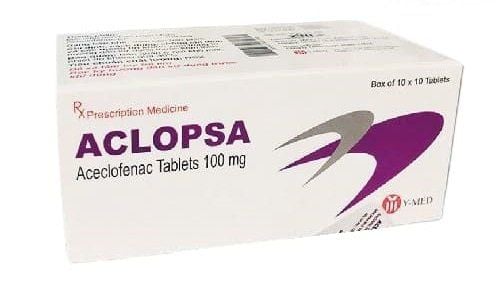This is an automatically translated article.
Tuspi drug has the main ingredient is Paracetamol 500mg, belongs to the group of non-steroidal anti-inflammatory drugs (NSAIDs), commonly used in the treatment of mild to moderate pain and fever. Learn the necessary information about the composition, usage, dosage, side effects of Tuspi to bring better treatment effect to the patient.
1. What is Tuspi?
What is Tuspi? Tuspi is available in different forms such as effervescent tablets, tablets or hard capsules. The most popular on the market is Tuspi effervescent tablet 500mg/tablet, with main ingredients including:
Active ingredient: Paracetamol 500mg. In addition, some Tuspi medicines may contain caffeine and Phenylephrine Hydrochloride as ingredients. Excipients just enough for 1 tablet of 500mg Paracetamol, also known as Acetaminophen (N-acetyl-p-aminophenol) is an active metabolite of a Phenacetin, which is an active ingredient used in the treatment of pain and fever. However, Paracetamol is not effective in treating inflammation. The main mechanism of action of Paracetamol is to inhibit the synthesis of Prostaglandin in the central nervous system mainly, thereby having analgesic and antipyretic effects. Paracetamol has no effect on inhibiting the synthesis of Prostaglandin on the periphery, so it has little impact on the cardiovascular and respiratory systems, does not change the Acid - Base balance, especially maintaining the content of Prostaglandin to protect the digestive tract. Therefore, Paracetamol is suitable for use in patients with a history of gastrointestinal disease, or in patients taking other NSAIDs that have an effect on peripheral prostaglandins.
Tuspi from some other manufacturers may contain caffeine and phenylephrine hydrochloride. In particular, caffeine when combined with the active ingredient Paracetamol can reduce pain and reduce fever better. In addition, Phenylephrine hydrochloride is a substance with anti-congestive effect in the nose through the mechanism of sympathetic nerve stimulation, acting mainly on Alpha-adrenergic receptors, thereby bringing effective treatment in cases of cold or flu.
2. What does Tuspi do?
Tuspi is indicated for the treatment of the following cases:
Mild to moderate pain: Headache, migraine, sore throat, menstrual pain, muscle pain, bone pain, pain after extraction toothache, pain after performing surgical, obstetric procedures...Febrile reaction after vaccination Antipyretic. People with nasal congestion, acute sinus, colds and flu.
3. Contraindications of Tuspi
Contraindications of Tuspi drug in the following cases:
Hypersensitivity to any ingredient in Tuspi medicine. History of allergy to Paracetamol or other NSAIDs. People with glucose-6-phosphate dehydrogenase deficiency (G6PD deficiency). Patients with a history of multiple anemias or severe cardiovascular and respiratory diseases such as severe coronary artery disease, severe hypertension, hyperthyroidism, are taking or have been treated with Monoamine oxidase inhibitors (MAO) in the past 14 days earlier. Patients with severe liver and kidney failure. Not recommended for use in children < 12 years old.
4. Dosage and how to use Tuspi
Adults or children ≥ 16 years old:
Dosage: Take 1-2 tablets (500-1000mg)/time every 4-6 hours. Take up to 8 tablets/day. Children from 12 to 15 years old:
Dose: Take 1 (500)/time every 4-6 hours. Take up to 4 tablets per day. Note: Tuspi is taken for up to 10 days in adults and 5 days in children.
5. Notes when using Tuspi
Side effects encountered when using Tuspi drug
Treatment with Tuspi drug in high doses or for a long time, can cause side effects as follows:
Uncommon: Skin manifestations such as skin rash, raised eyebrows jute. Gastrointestinal symptoms such as nausea or vomiting. Hematologic signs such as decreased white blood cell count, neutropenia, and pancytopenia may result in anemia. Side effects on the urinary system such as kidney failure, nephrotoxicity when taking long-term doses. Rare: Stevens-Johnson syndrome, Lyell's syndrome, toxic epidermal necrolysis, acute generalized rash, generalized pustulosis. The most severe can be anaphylactic shock. Patients should stop taking the drug as soon as they detect the above symptoms after using Tuspi. In addition, it is necessary to carefully read the overdose management section on the leaflet or promptly notify the doctor or pharmacist for timely treatment.
Notes on using Tuspi in subjects
Be careful when using Tuspi in the following cases: People with Phenylketonuria - people with a history of bronchial asthma, liver failure, kidney failure, chronic malnutrition. Alcoholics, people who are dehydrated, people with a history of anemia. Pregnancy: Current studies suggest that there is no evidence of harm in pregnant women using paracetamol at the recommended dose. However, when you want to use Tuspi in pregnant women, you need to follow the instructions of an obstetrician-gynecologist. Lactation: Paracetamol can pass into breast milk, but in very small amounts and does not affect the baby. Therefore, breastfeeding is not a contraindication to Tuspi. Drivers or machine operators are not affected much after taking Tuspi.
6. Tuspi . drug interactions
Tuspi is not suitable when used with the following drugs:
Anticoagulants. Anticonvulsants such as Phenytoin, Carbamazepine, Barbiturates. Probenecid . Anti-tuberculosis drugs such as Isoniazid. Above is general information and notes when using Tuspi. In order to bring the best treatment results when using Tuspi, patients and relatives should carefully read the information of the drug and strictly follow the instructions of the treating doctor.
Follow Vinmec International General Hospital website to get more health, nutrition and beauty information to protect the health of yourself and your loved ones in your family.
Please dial HOTLINE for more information or register for an appointment HERE. Download MyVinmec app to make appointments faster and to manage your bookings easily.













